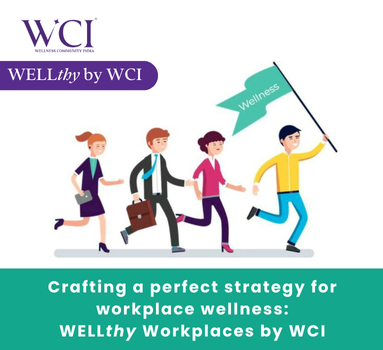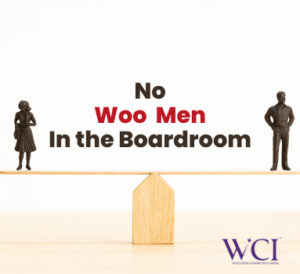
23 Oct 2024
Crafting a perfect strategy for workplace wellness: WELLthy Workplaces by WCI
Let’s explore the trends redefining workplace wellness, for organisational success and growth through a motivated, happier and a healthier workforce.
It is estimated that an average person will spend one-third of their life working, and another one-third sleeping or attempting to sleep. This definitely makes our time at the workplace, contributing over 50% of our awake time, an integral part of our life and overall wellness.
Workplace landscape has been constantly evolving, and today’s workforce seeks more than just a competitive paycheck. They crave for recognition and growth, challenging assignments and exposure, mindful and compatible leadership, a progressive and supportive work environment, and a healthy balance between their personal and professional lives. Instead of competing for fancy designations or paychecks, they are prioritising personal goals and a meaningful life, representing a new and fresh perspective on the very purpose of our work life. And employers need to recognise and support this mindset shift, and acknowledge that job fulfilment has now evolved beyond traditional career paths, making workplace wellness strategies highly critical for successful business outcomes.
Only 23% of global workforce is engaged at work : A wake-up call for corporates worldwide
According to 2024 report by Gallup, a staggering 77% of the global workforce is disengaged, often participating in what is known as ‘quiet quitting’, where they put in minimal effort and are psychologically disconnected from their work. This high level of disengagement is a significant concern, contributing to increased workplace stress and reduced productivity. These alarming statistics and recent cases of employee burnout, highlight an urgent crisis in the context of workplace wellness that organisations can no longer afford to ignore.
So, what is workplace wellness?
Occupational wellness which is a core dimension of wellness means seeking fulfilment from one’s work and career, whilst striking the right balance between one’s personal and professional life goals. Post-pandemic, this dimension has seen heightened awareness and recognition leading to wellness at workplace becoming an extremely strategic agenda for employees. Employers have realised that workplace wellness has a direct impact on the wellness of their employees, and similarly the wellness of their employees has a direct impact on the wellness of their business. And hence improving workplace wellness in turn means harnessing organisational success and growth. No doubt workplace wellness has emerged as an integral part of corporate strategy and business success over the recent years. It is no longer restricted to basic health perks or namesake sporadic sessions, but it now stretches far and wide to encompass comprehensive and meaningful initiatives that address not only physical health but also their mental, financial, intellectual, occupational, social and environmental wellness.
Popular workplace wellness initiatives
Health screenings and workshops, remote and flexible working resources, mental health support, nutrition and fitness programs, women wellness programs, DEI (diversity, equity, and inclusion) initiatives, fun-filled and team-building events, are the most commonly deployed programs. Most mid-size and large corporates have been offering these in some form or the other, especially since the post-pandemic period. Now even smaller companies and government entities have embraced these initiatives. In fact, at WCI, we regularly curate progressive, innovative and fun-filled initiatives, such as financial wellness workshops, chair yoga, on-site fitness facilities, self-defence classes for women, wellness challenges and incentive programs, family fun events, amongst many others for our corporate clients. From women to millennials to on-field workforce to leadership, each of these segments have their own set of challenges and wellness requirements, and hence organisations are trying to curate non-traditional wellness programs that elevate employee engagements and experiences across the strata of their workforce.
WCI takes immense pride in a consultative approach to workplace wellness. We curate wellness strategies that are guided by the existing challenges and workforce-specific requirements. There is no one-size-fits-all since every workplace is unique and diverse. Our workplace advisory module – WELLthy Workplaces – with our unrivalled multi-dimensional wellness approach, has been well received with corporates across industry types, sizes and demographics. Read more about WELLthy here.
Benefits of a sound and sustainable workplace wellness strategy
Employee workforce is the greatest asset and strength, and a well-curated employee wellness strategy will substantially elevate morale, productivity and performance, and thereby successful business outcomes. And having a credible partner like WCI will ensure a seamless execution of a meaningful and a sustainable wellness strategy across your multi-generational workforce, from Baby boomers to Gen X to Gen Y aka Millennials to Gen Z to Gen A. Below are some of the key benefits that will follow:
- Improved employee wellness across all 7 dimensions of wellness (physical, mental, financial, intellectual, occupational, social and environmental) leading to balanced life and long-term career success
- Enhanced employee health that supports healthy lifestyles, timely preventive care and early detection of diseases
- Higher employee engagement and retention, which in turn improves output, and reduces absenteeism and attrition
- Better ROI with higher employee efficiency and productivity, reduced healthcare spends, and lower recruitment and retraining costs
- Mindful leadership fosters a sense of belongingness and psychological safety, occupational enrichment and intellectual growth
- Positive organisational culture and enhanced employee satisfaction drives individuals and teams to perform at peak levels, leading to cohesive and high-performing growth-oriented workforce, which in turn boosts organisational growth and success
- Flourishing and energetic work culture replaces workplace toxicity and micro-aggressions with improved collaboration, communication, mindfulness and social connections
- Diversity in teams boosts equity, inclusiveness, innovation, creativity, and rounded decision-making
- Most importantly, these programs elevate your employer branding making you the preferred employer, guaranteeing an access to credible and top talent
Tailoring wellness programs that work magic for the corporate world
The most important question here is how to craft that perfect strategy for workplace wellness? WCI offers a wide range of advisory services, and WELLthy Workplaces is one of our flagship advisory modules. Our consultative approach takes a deep dive to understand unique requirements of each client. By assessing factors such as workforce demographics, culture and challenges, we curate wellness strategies that are precisely tailored to align with a client’s strategic business goals. We excel in crafting wellness modules that have a multi-dimensional focus, and clients can choose from a variety of wellness programs. By seamlessly integrating wellness initiatives with your business goals, we help reduce the burden on your management and human resource teams, allowing them to focus on other critical areas of business growth. We are proud of our distinguished partners, who are subject matter experts in their respective fields, and together, we ensure each program is impactful and engaging. Whether it is making your will, women wellness, desk fitness routine, mindfulness practice, digital wellness, CSR, environmental campaign, mental wellness, financial planning, ergonomic consulting or any other; wellness and sustainability are always at the core, fostering physical, mental, financial, intellectual, occupational, social and environmental wellness within your workplace.
The future of workplace wellness is poised for significant transformation, driven by an increasing focus on multi-dimensional wellness. At WCI, we are poised to lead this evolution, leveraging our expertise to curate, innovate and execute wellness strategies that elevate employee wellness, fostering a motivated, happier and a healthier workforce. Reach out to us if you are an organisation looking to support, elevate or recalibrate your workplace wellness strategies, and co-create a culture of wellness in line with the emerging trends and the future of work. Sign up now for our most popular advisory WELLthy Workplaces and win over your employees with credible and sustainable strategies that will definitely work! Read more about WELLthy at https://wci.org.in/advisory-services/
Quiz time. Let’s unwind by testing your workplace lingo.
We have been hearing of jargon such as Digital nomads, Great resignation, Hustle culture, Intrapreneurship, Moonlighting or Side hustling, Toxic workplace etc. Below are some recent ones that are shaking up the corporate world, so let’s see how many of these you can spot at your workplace.
- Boreout: While burnout is an outcome of excessive work related stress, boreout stems from underload at work, resulting in lack of motivation and disengagement at work. In simple terms, burnout is when you are overstimulated, and boreout is when you are understimulated.
- Career Cushioning: When employees prepare for an unexpected job loss by creating back-up career opportunities either by upskilling, networking, or keeping an eye out for alternate roles just in case of a sudden surprise. It’s like having a safety net for your career.
- Coffee Badging: The practice of employees badging into office for just a short time (enough to grab a coffee) while predominantly working remotely, sometimes just to maintain visibility or for a quick meeting.
- Dry promotion: When promotion comes with an increase in job responsibilities without a corresponding increase in compensation or designation. This may happen when organisations reward their high-performing employees whilst maintaining budget constraints.
- Emotional salary or pay-check: The emotional pay-check encompasses intangible non-monetary benefits that enhance work-life balance such as time or location flexibility, positive and inclusive work culture, mindful leadership, psychological safety, and overall wellness.
- Lazy girl job: These are jobs that come with a comfortable salary, reasonable benefits and standard working hours, and are highly popular with younger generation. So don’t get misled bythe word lazy (or girl). While it doesn’t necessarily imply lack of ambition, it does imply no burnout by seeking healthy boundaries.
- Office Peacocking: It means the deliberate makeover of office spaces into inviting havens to tempt employees to spend more time at workplace instead of working remotely. It may involve setting up comfortable furnishings, natural light, greenery, etc transforming the once-typical cubicle-type grid into a vibrant lounge-style setting aimed at enhancing employee comfort and productivity in physical workspaces.
- Quiet Ambition: The term, dubbed by Fortune, is the pursuit of a balanced and meaningful life at work, where employees are quietly redefining what true success means to them. Contrary to the traditional and louder form of ambition, it represents a quieter yet forceful inner pursuit where an employee no longer works solely for the sake of their professional or organisational growth, but for a career that fits around fulfilling their personal goals.
- Quiet Firing: When an employer curtails coaching, support and career development opportunities for an employee, without formally terminating him or her, by using manipulation to persuade the employee to leave. Some quiet firing tactics include denied raises and stalled promotions, failure to give feedback, overwork or underwork, unfair or unequal treatment, etc.
- Quiet Hiring: It refers to the practice of offering new responsibilities and opportunities to existing staff, instead of recruiting new staff, by leveraging on current employees’ capabilities to acquire new skills. This involves filling job roles internally or through reassignments, without any new hiring. A boon or a bane?
- Quiet Quitting: Stealth mode engaged! Doing the bare minimum job responsibilities and putting in no more time, effort, or enthusiasm than what is necessary. It’s about setting boundaries without making a dramatic exit.
- Quiet Thriving: It is about finding a ‘purpose’ in an otherwise frustrating work environment, by making some mental shifts and taking specific actions to feel ‘engaged’ at work. This is a positive alternative to quiet quitting, helping employees build resilience despite an unfavourable work environment.
- Resenteeism: Here an employee sticks around the job despite being fundamentally unhappy either with pay, benefits, or workplace culture. Resenteeism is coined from the words ‘resentment’ and ‘absenteeism’, where employees continues working in roles they find dissatisfying. This slightly resembles quiet quitting, and they sometimes just hang in there because they can’t afford to leave or find an alternative job.
- Well-being washing: Like greenwashing, well-being washing is when an organisation portrays its image as being focussed about employees’ well-being than they actually do in their actions. Tall or fake promises and little to nothing to deliver. This could be to please the media whereas in reality the employees find themselves neglected or in false sense of support or subjected to a toxic work culture.
There are many others. Bleeding edge, Boomerang employee, Copycat layoffs, Fractional work, Gaslighting, Glass cliff, Ghost jobs, Great gloom, Holacracy, Loud quitting, Monk mode, Portfolio careers, Productivity theatre, Proximity bias, Quiet cutting, Quiet management, Quiet vacationing, Quittok, Rage applying, Sick guilt, Shift shock, Social loafing, Swarm intelligence, Talent debt, Talent velocity, Unretirement, Workfluencers, etc. Do check these out too.







